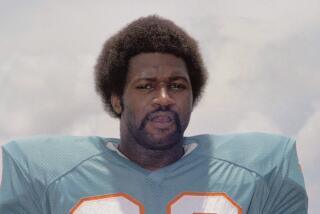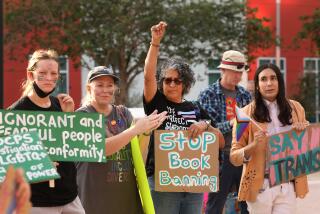Henry Morris, 87; 1961 Book Is Credited With Reviving the Creationism Movement
Henry M. Morris, a hydraulics engineer widely regarded as the father of modern creationism whose fusion of scientific and biblical knowledge rekindled the anti-evolution movement more than 40 years ago, has died. He was 87.
Morris died Saturday at Sharp Grossmont Hospital near San Diego after a series of strokes, said Larry Vardiman, chief operating officer of the influential Institute for Creation Research in Santee, Calif., that Morris founded in 1970.
With a torrent of words -- he wrote more than 60 books -- Morris laid an intellectual framework that attempted to scientifically explain the theory of divine creation. Morris’ thinking also influenced the contemporary argument for intelligent design, the concept that a supreme designer had a hand in evolution.
What Charles Darwin’s “Origin of Species” was to evolution, Morris’ 1961 book “The Genesis Flood: The Biblical Record and Its Scientific Implications” was to late-20th century creationism.
The book, considered the first major attempt to defend creationist principles through scientific observation, became the bible of the movement. Still in print 45 years later, it has sold tens of thousands of copies.
By treating the Bible as an error-free account of history, Morris tried to scientifically explain how the world could be created in six 24-hour days. Using the Old Testament book of Genesis as a guide, one of the main theories of “The Genesis Flood” offered an explanation for how flood geology could have speedily shaped the Earth.
The book, co-written with John C. Whitcomb, was an instant hit among Christian fundamentalists searching for evidence that Noah’s flood, not billions of years of wind and water action, could have sculpted the planet.
The flood dominates the book, even though some theologians view the story of Noah as a fable or a record of local floods. Morris argued that the Earth’s geology bore scars of a global deluge.
He also contended that the layers of fossils that geologists believe were deposited over billions of years could have been deposited within weeks or months of the flood as the least-fit creatures perished.
Asserting that only Noah’s family and the animals on the ark survived, he calculated the ark’s cargo capacity at roughly 522 railroad cars that could hold about 35,000 animals capable of repopulating the Earth.
Many mainstream scientists dismissed the book’s findings as religious propaganda dressed up with scientific jargon.
John Sanford, a Cornell University professor with a doctorate in plant breeding, is among the scientists who found meaning in Morris’ work.
“He impacted me in a major way,” Sanford told the San Diego Union-Tribune. “I was an evolutionist and basically never questioned it. At this point, I find [evolution] an almost indefensible position.”
For challenging an almost universally accepted paradigm, Morris will be remembered “as one of the high-impact individuals of his generation,” Sanford said.
Among Morris’ chief critics was Stephen Jay Gould, a renowned paleontologist and leading evolutionist who died in 2002. He acknowledged “The Genesis Flood” as “the founding document of the creationist movement” but took issue with the teachings of Morris and his institute.
“They have this absurd notion that something that occurs in the past and that is not subject to direct observation is not provable,” Gould told The Times in 1991. “That’s nonsense.... There is a mystery as to how evolution occurs, but there is not a whole lot of doubt as to whether it occurs.”
When Kenneth R. Miller, a biology professor at Brown University, was asked to debate Morris in 1981, so many people bought tickets that the event had to be held in the biggest building on campus -- a hockey rink.
“I found Morris to be unfailingly polite, a real gentleman and a person who was a sincere and committed Christian,” Miller said.
“He also was profoundly wrong, profoundly misguided in his view of science and Christianity, and he has ultimately done damage,” Miller said, partly by putting science at loggerheads with religion.
“He also twisted science, selectively using data to support something that is scientifically unsupportable, such as the notion that the Earth is 6,000 years old,” Miller said. (Contemporary geologists estimate the Earth to be 4.5 billion years old.)
In “Finding Darwin’s God: A Scientist’s Search for Common Ground Between God and Evolution,” Miller’s 1999 book that argues that religion and science can coexist, he tells of asking Morris after a debate: “Do you actually believe all this stuff?”
“Ken, you’re intelligent, you’re well-meaning ....” Miller recalled Morris saying. “But you are also young .... In a question of such importance, scientific data aren’t the ultimate authority. Even you know that science is wrong sometimes.”
Born in Dallas in 1918, Henry Madison Morris Jr. was barely in grade school when the creationists and Darwin evolutionists famously wrangled during what came to be known as the Scopes monkey trial.
As a child, Morris was indifferent to religion but came to accept the Bible as the literal, truthful word of God -- a central tenet of creationism -- after graduating in 1939 with a bachelor’s degree in civil engineering from Rice University.
“He saw that evolution held sway with all of science and in the church,” the creation institute’s Vardiman said. “There was no strong voice that was taking the Bible literally. He felt that God was calling him to be that person.”
In 1946, Morris wrote his first religious tract, “That You Might Believe.”
By the time he wrote “The Genesis Flood,” Morris was head of the civil engineering department at Virginia Polytechnic Institute in Blacksburg, Va., and held master’s and doctorate degrees in hydraulics from the University of Minnesota.
At first, the book generated little attention among his colleagues. As his celebrity grew, a new administrator declared Morris too controversial. When he was asked to drop his creationist writings from his resume, Morris knew it was time to move on.
During his 13 years at the university, the civil engineering program had become one of the largest in the nation, and his 1963 textbook on applied hydraulics is still in use. Away from campus, a church that Morris helped found in Blacksburg still exists.
In 1970, he moved to San Diego and co-founded what is now known as San Diego Christian College in El Cajon with Tim LaHaye, a local minister who is coauthor of the “Left Behind” series of apocalyptic novels.
That same year, Morris launched the Institute for Creation Research, a graduate school and research organization, after breaking away from another creationist group he had helped found.
Since 1981, the institute has awarded about 100 master’s degrees. Forty students are studying for degrees in astro-geophysics, biology, geology and science education.
In 1989, the state Department of Education tried to suspend the institute’s accreditation, claiming it taught religious theory, not science. A lawsuit was settled in the institute’s favor, and accreditation was restored.
After Morris retired as president of the institute in 1995, his son John succeeded him. His older son, Henry Morris III, is the organization’s executive vice president.
Other survivors include Morris’ wife of 66 years, Mary Louise; three daughters; 17 grandchildren; and nine great-grandchildren. A son, Andrew, died in 1989.
At least one advocate for intelligent design sees Morris as rescuing a debate from near-extinction.
“Ideas can die because there is just no one to think about them,” Paul Nelson, a fellow with the Discovery Institute, a leading Seattle-based organization that promotes intelligent design, said last year. “I love the fact that Dr. Morris kept alive dissent from Darwinian evolution.”







